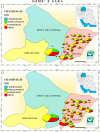Gender-related differences in the association of serum levels of vitamin D with body mass index in northern Iranian population: the PERSIAN Guilan Cohort Study (PGCS)
- PMID: 36482384
- PMCID: PMC9733319
- DOI: 10.1186/s40795-022-00637-1
Gender-related differences in the association of serum levels of vitamin D with body mass index in northern Iranian population: the PERSIAN Guilan Cohort Study (PGCS)
Abstract
Background: Vitamin D (VD) insufficiency has now become a global problem throughout the world. The association between increasing body mass index (BMI) and VD insufficiency has attracted great attention in recent researches. The aim was to study if BMI was independently associated with serum 25-hydroxy VD in a large population-based study, specify by gender.
Methods: Data on 9520 adults 35 years and older participating in PERSIAN Guilan Cohort Study (PGCS) were used. Serum levels of 25-hydroxy VD less than 20 ng/mL (50 nmol/L) was used as a measure of VD inadequacy. Multiple logistic and linear regression analyses were used to estimate the strength of the association between VD and BMI before and after adjusting for demographic factors and lifestyle variables.
Results: After adjustment in male population, overweight (adjusted OR = 1.2, P < 0.05) and obese (adjusted OR = 1.4, P > 0.05) individuals were more likely to have VD inadequacy than normal weight counterparts. Moreover, there was a weak inverse linear association between BMI and serum 25 (OH) D levels in males (β = -0.14, P value > 0.05). In contrast, no significant associations between BMI and serum 25 (OH (D levels were observed in females. In male population, higher BMI were associated with lower serum vitamin 25 (OH) D levels.
Conclusions: However, association between BMI and VD level was not observed in female population. The suggestion of current study for public health was special consideration to serum VD levels in over weight and obese males.
Keywords: Body Mass Index; Gender; Vitamin D.
© 2022. The Author(s).
Conflict of interest statement
None.
Figures
Similar articles
-
Association of Serum Levels of Vitamin D with Blood Pressure Status in Northern Iranian Population: The PERSIAN Guilan Cohort Study (PGCS).Int J Gen Med. 2020 Mar 11;13:99-104. doi: 10.2147/IJGM.S244472. eCollection 2020. Int J Gen Med. 2020. PMID: 32210606 Free PMC article.
-
The association between tobacco smoke exposure and vitamin D levels among US general population, 2001-2014: temporal variation and inequalities in population susceptibility.Environ Sci Pollut Res Int. 2022 May;29(22):32773-32787. doi: 10.1007/s11356-021-17905-5. Epub 2022 Jan 12. Environ Sci Pollut Res Int. 2022. PMID: 35020139 Free PMC article.
-
Vitamin D deficiency associated with reproductive factors in northern Iranian women: The PERSIAN Guilan Cohort Study (PGCS).Clin Nutr ESPEN. 2020 Aug;38:271-276. doi: 10.1016/j.clnesp.2020.03.022. Epub 2020 Apr 22. Clin Nutr ESPEN. 2020. PMID: 32690168
-
Serum 25(OH)D and lipid levels in Chinese obese and normal weight males before and after oral vitamin D supplementation.Biomed Environ Sci. 2013 Oct;26(10):801-7. doi: 10.3967/bes2013.003. Biomed Environ Sci. 2013. PMID: 24215874
-
The effect of vitamin D supplementation on serum 25(OH)D in thin and obese women.J Steroid Biochem Mol Biol. 2013 Jul;136:195-200. doi: 10.1016/j.jsbmb.2012.12.003. Epub 2012 Dec 11. J Steroid Biochem Mol Biol. 2013. PMID: 23246640 Free PMC article. Review.
Cited by
-
Seasonal and sex-related variation in vitamin D status and its association with other biochemical markers in young individuals: A cross-sectional study.PLoS One. 2024 Mar 29;19(3):e0298862. doi: 10.1371/journal.pone.0298862. eCollection 2024. PLoS One. 2024. PMID: 38551916 Free PMC article.
References
-
- Fallahzadeh H, Saadati H, Keyghobadi N. Estimating the prevalence and trends of obesity in Iran populations from 2000 to 2011: a meta-analysis study. SSU_J. 2017;25(9):681–689.
LinkOut - more resources
Full Text Sources

